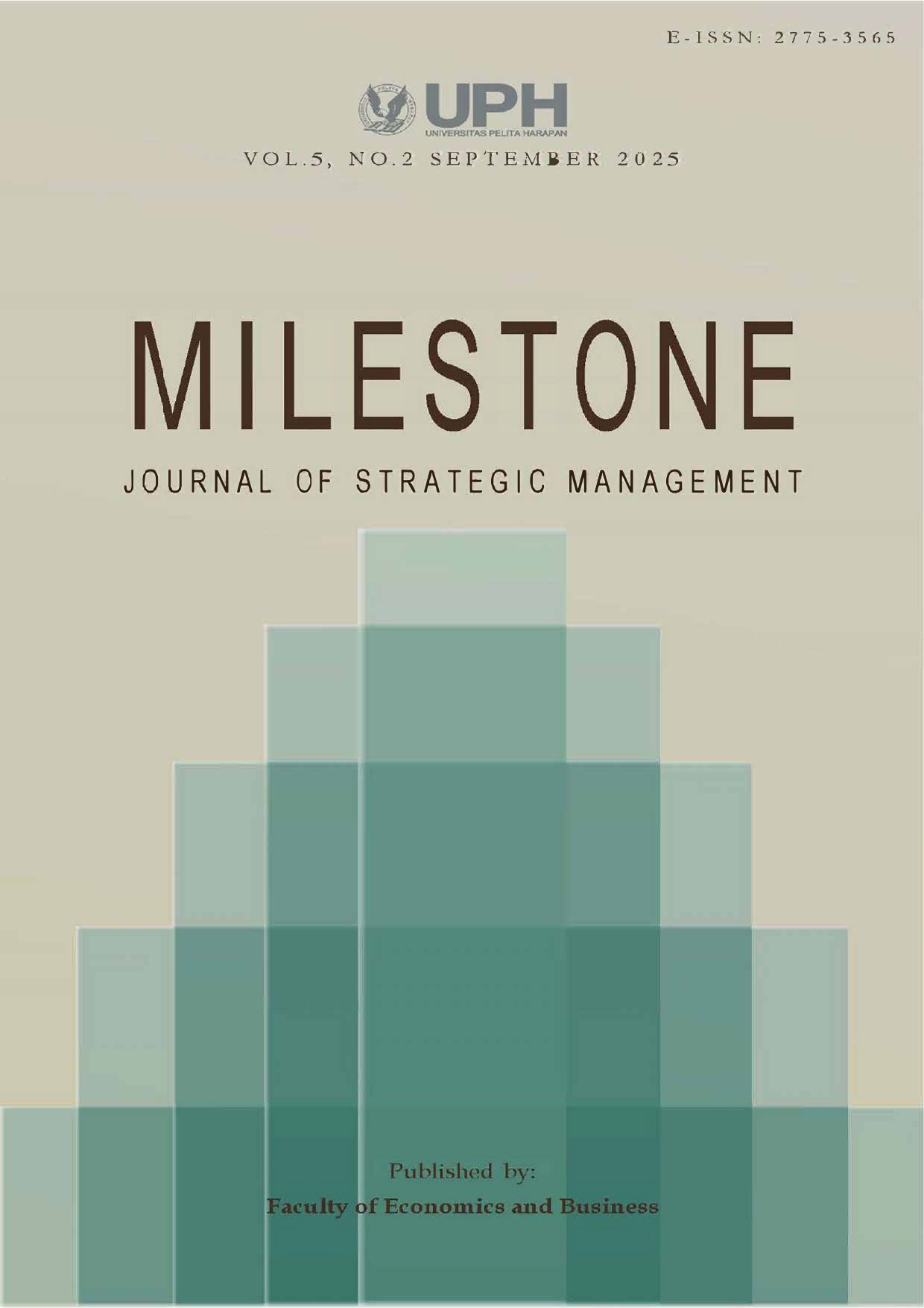Social and Emotional Drivers of Engagement with AI Virtual Influencers: A Qualitative Study in Indonesia
DOI:
https://doi.org/10.19166/ms.v5i2.9852Λέξεις-κλειδιά:
Virtual Influencers, AI Marketing, Consumer Engagement, Emotional Resonance, IndonesiaΠερίληψη
The growing presence of AI-powered virtual influencers (VIs) on social media has introduced new dynamics in digital marketing, yet little is known about how consumers in emerging markets perceive and respond to these synthetic personas. This study investigates the factors that shape consumer acceptance of virtual influencers in Indonesia, focusing on the interrelationship between social influence, performance expectancy, emotional resonance, and willingness to engage. Employing a qualitative research design, 25 in-depth semi-structured interviews with Indonesian consumers aged 18–35 were conducted, reaching thematic saturation. Thematic analysis was conducted using NVivo 14, integrating both deductive and inductive coding strategies. Findings reveal four major themes and twelve subthemes: (1) social influence functions as a cultural endorsement mechanism, shaping normative beliefs; (2) performance expectancy is driven by informational credibility, entertainment value, and behavioral consistency; (3) emotional resonance—expressed through perceived authenticity and psychological comfort—is central to consumer attachment; and (4) willingness to use VIs is closely linked to digital identity projection and contextual social legitimacy. A clear majority of participants (around four out of five) described positive evaluations of VIs, while a minority expressed skepticism and emotional discomfort, highlighting ethical and psychological boundaries in AI–human interaction. The study contributes to a deeper understanding of how social and emotional mechanisms converge in shaping digital consumer behavior, offering practical insights for marketers and advancing theory on technology acceptance in culturally nuanced settings.
Αναφορές
Azzahra, J., & Pratama, M. C. (2024). The hyperreality of virtual influencer Lentari Pagi on Instagram. International Journal Software Engineering and Computer Science, 4(1), 165–174. http://dx.doi.org/10.35870/ijsecs.v4i1.2304
Belanche, D., Casaló, L. V., & Flavián, M. (2024). Human versus virtual influences, a comparative study. Journal of Business Research, 173(8), 1–13. http://dx.doi.org/10.1016/j.jbusres.2023.114493
Braun, V., & Clarke, V. (2021). One size fits all? What counts as quality practice in (reflexive) thematic analysis? Qualitative Research in Psychology, 18(3), 328–352. https://doi.org/10.1080/14780887.2020.1769238
Chatterjee, S., Chaudhuri, R., & Vrontis, D. (2023). Masstige marketing: An empirical study of consumer perception and product attributes with moderating role of status, emotion, and pride. Journal of Business Research, 155, 1–13. https://doi.org/10.1016/j.jbusres.2022.113401
Cheng, X., Zhang, X., Cohen, J., & Mou, J. (2022). Human vs. AI: Understanding the impact of anthropomorphism on consumer response to chatbots from the perspective of trust and relationship norms. Information Processing & Management, 59(3), 1–16. https://doi.org/10.1016/j.ipm.2022.102940
Chi, N. T. K., & Vu, N. H. (2023). Investigating the customer trust in artificial intelligence: The role of anthropomorphism, empathy response, and interaction. CAAI Transactions on Intelligence Technology, 8(1), 260–273. https://doi.org/10.1049/cit2.12133
Christanti, C., & Kembau, A. S. (2024). Pengaruh strategi pemasaran konten dan afiliasi terhadap pembelian impulsif: Peran mediasi pemasaran viral dan kepercayaan. Modus, 36(2), 198–223. https://doi.org/10.24002/modus.v36i2.8787
Cokki, C., Soelaiman, L., & Tjokrosaputro, M. (2025). The impact of virtual influencer product placement on brand awareness in Indonesia. Innovative Marketing, 21(2), 119–133. https://doi.org/10.21511/im.21(2).2025.10
Dwivedi, Y. K., Rana, N. P., Jeyaraj, A., Clement, M., & Williams, M. D. (2020). Re-examining the unified theory of acceptance and use of technology (UTAUT): Towards a revised theoretical model. Information Systems Frontiers, 22(4), 719–734. https://doi.org/10.1007/s10796-018-9871-3
Feng, Y., Chen, H., & Xie, Q. (2023). AI influencers in advertising: The role of AI influencer-related attributes in shaping consumer attitudes, consumer trust, and perceived influencer–product fit. Journal of Interactive Advertising, 24(1), 26–47. http://dx.doi.org/10.1080/15252019.2023.2284355
Guest, G., Namey, E., & Chen, M. (2020). A simple method to assess and report thematic saturation in qualitative research. PLOS ONE, 15(5), 1–17. https://doi.org/10.1371/journal.pone.0232076
Gursoy, D., Chi, O. H., Lu, L., & Nunkoo, R. (2019). Consumers' acceptance of artificially intelligent (AI) device use in service delivery. International Journal of Information Management, 49, 157–169. https://doi.org/10.1016/j.ijinfomgt.2019.03.008
Hu, Y., Zhang, Y., & Wang, S. (2023). Parasocial interaction with virtual influencers: The role of perceived authenticity and cultural context. Computers in Human Behavior, 139, 11–30.
Jhawar, A., Kumar, P., & Varshney, S. (2023). The emergence of virtual influencers: A shift in the influencer marketing paradigm. Young Consumers, 24(4), 468–484. https://doi.org/10.1108/YC-02-2023-1686
Kembau, A. S., & Lendo, F. B. (2025). Augmented Reality in fashion and beauty product marketing: A preliminary study of immersive marketing in Indonesian e-commerce. Proceedings of the 12th Gadjah Mada International Conference on Economics and Business, 12, 379–395. https://doi.org/10.2991/978-94-6463-692-5_20
Kembau, A. S., Bernanda, D. Y., Kumaat, A. P., & Doa, F. N. (2025). What drives the adoption of virtual influencers in Indonesia? A TAM2 perspective on social influence and cognitive absorption. Economics and Digital Business Review, 6(1), 575–591. https://ojs.stieamkop.ac.id/index.php/ecotal/article/view/2093
Kembau, A. S., Kolondam, A., & Mandey, N. H. J. (2024). Virtual influencers and digital engagement: Key insights from Indonesia's younger consumers. Jurnal Manajemen Pemasaran, 18(2), 123–136. https://doi.org/10.9744/pemasaran.18.2.123-136
Kemp, S. (2023, February 09). Digital 2023: Indonesia report. Datareportal. https://datareportal.com/reports/digital-2023-indonesia
Kemp, S. (2025, February 25). Digital 2025: Indonesia. DataReportal. https://datareportal.com/reports/digital-2025-indonesia
Kim, J., & Biocca, F. (1997). Telepresence via television: Two dimensions of telepresence may have different connections to memory and persuasion. Journal of Computer-Mediated Communication, 25(3), 188–203.
Laszkiewicz, A., & Kalinska‐Kula, M. (2023). Virtual influencers as an emerging marketing theory: A systematic literature review. International Journal of Consumer Studies, 47(6), 2479–2494. https://doi.org/10.1111/ijcs.12956
Lee, J. E., & Watkins, B. (2016). YouTube vloggers’ influence on consumer luxury brand perceptions and intentions. Journal of Business Research, 69(12), 5753–5760. https://doi.org/10.1016/j.jbusres.2016.04.171
Longoni, C., & Cian, L. (2020). Artificial intelligence in utilitarian vs. hedonic contexts: The “word-of-machine” effect. Journal of Marketing, 86(1), 91–108. https://doi.org/10.1177/0022242920957347
Luo, L., & Kim, W. (2023). How virtual influencers’ identities are shaped on Chinese social media: A case study of ling. Global Media and China, 9(3), 325–343. https://doi.org/10.1177/20594364231188353
Mendelson, A. L., & Papacharissi, Z. (2020). Real conversations in virtual spaces: The new reality of parasocial interaction. New Media and Society, 22(1), 125–141.
Munnukka, J., Talvitie-Lamberg, K., & Maity, D. (2022). Anthropomorphism and social presence in human–virtual influencer interaction. Computers in Human Behavior, 135, 1–12. https://doi.org/10.1016/j.chb.2022.107343
Saldaña, J. (2021). The coding manual for qualitative researchers (4th ed.). SAGE Publications.
Taslaud, G. (2025, August 03). Influencer marketing in Indonesia: 2025 outlook. INSG. https://www.insg.co/influencer-marketing-indonesia/
Uysal, E., Alavi, S., & Bezençon, V. (2022). Trojan horse or useful helper? A relationship perspective on artificial intelligence assistants with humanlike features. Journal of the Academy of Marketing Science, 50(6), 1153–1175. https://doi.org/10.1007/s11747-022-00856-9
Vafaei-Zadeh, A., Nikbin, D., Wong, S. L., & Hanifah, H. (2024). Investigating factors influencing AI customer service adoption: An integrated model of stimulus–organism–response (SOR) and task-technology fit (TTF) theory. Asia Pacific Journal of Marketing and Logistics, 37(6), 1465–1502. https://doi.org/10.1108/APJML-05-2023-0442
Vasileiou, K., Barnett, J., Thorpe, S., & Young, T. (2018). Characterising and justifying sample size sufficiency in interview-based studies: Systematic analysis of qualitative health research over a 15-year period. BMC Medical Research Methodology, 18(1), 1–18. https://doi.org/10.1186/s12874-018-0594-7
Venkatesh, V. (2022). Adoption and use of AI tools: A research agenda grounded in UTAUT. Annals of Operations Research, 308(4), 641–652. https://link.springer.com/article/10.1007/s10479-020-03918-9
Yu, J., Dickinger, A., So, K. K. F., & Egger, R. (2024). Artificial intelligence-generated virtual influencer: Examining the effects of emotional display on user engagement. Journal of Retailing and Consumer Services, 76, 1–10. https://doi.org/10.1016/j.jretconser.2023.103560
Zhang, W., Jiang, M., & Kim, H. (2024). Human vs. AI influencer activism: Exploring self-branding and issue advocacy effectiveness through social influence processes. Journal of Interactive Advertising, 24(4), 1–12. https://doi.org/10.1080/15252019.2024.2407776
Λήψεις
Δημοσιευμένα
Τεύχος
Ενότητα
Άδεια
Πνευματική ιδιοκτησία (c) 2025 Agung Stefanus Kembau, Devi Yurisca Bernanda, Arief Perdana Kumaat, Fresi Breatrix Lendo, Fidelia Novena Doa

Αυτή η εργασία είναι αδειοδοτημένη υπό το Creative Commons Attribution-ShareAlike 4.0 International License.
Authors who publish with this journal agree to the following terms:
1) Authors retain copyright and grant the journal right of first publication with the work simultaneously licensed under a Creative Commons Attribution License (CC-BY-SA 4.0) that allows others to share the work with an acknowledgement of the work's authorship and initial publication in this journal.
2) Authors are able to enter into separate, additional contractual arrangements for the non-exclusive distribution of the journal's published version of the work (e.g., post it to an institutional repository or publish it in a book), with an acknowledgement of its initial publication in this journal.
3) Authors are permitted and encouraged to post their work online (e.g., in institutional repositories or on their website). The final published PDF should be used and bibliographic details that credit the publication in this journal should be included.





